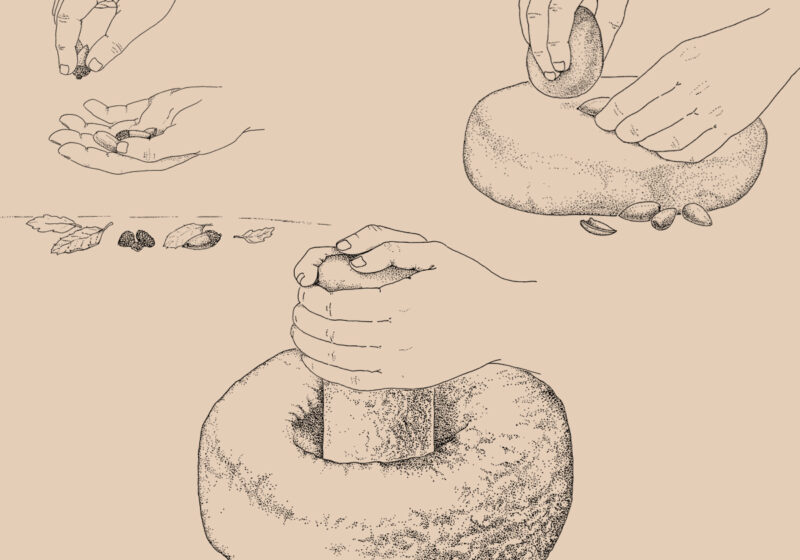“Today, we’ve almost forgotten about the nourishing acorn, which almost never figures in most peoples’ diet. More’s the pity, for this important ancient California food once sustained thousands of people in Santa Barbara County and elsewhere, through drought and years of plenty. Acorns were a staff of life for native Californians.”
Brian Fagan
Read the full article “Acorn Eating: A Santa Barbara Tradition” by Brian Fagan, clicking here.
Cold Water Method
This method is preferred when making acorn flour for baking. It doesn’t remove some of the starches that help the flour stick to itself, giving better results when baking.
You will need:
- Whole acorns, freshly fallen, choose ones without any insect holes
- Nutcracker or hammer for cracking
- Bucket of water
- Blender
- Jars
- Colander, cheesecloth
- Baking sheet
- Food processor or coffee grinder
Crack the acorns into a bucket of water to keep them from darkening. Extract from the shells and drop into a large bowl of water.
Put the acorns into a blender, filling to about half and covering with fresh water. Blend until smooth and then pour into large jars, about half full and cover with a little more fresh water. Seal the jars and shake before putting in the refrigerator.
Once a day, pour the water off and replace with fresh water. Shake and replace in the refrigerator. Continue for several days to several weeks, depending on the variety of acorn. Taste periodically—they are done when they taste bland and not bitter.
Pour the acorn mixture into a colander lined with a lightweight dishtowel or cheesecloth. Drain and then squeeze out as much moisture as you can.
Spread evenly onto a baking sheet and place in a 200° oven or a dehydrator until it is dry. After it is dried, if it is still a little coarse, grind it in a food processor or a coffee grinder. You will most likely want to mix the acorn flour with an equal amount of wheat or other flours in baking recipes. The acorn flour will be heavier and have a nutty flavor.
Hot Water Method
You will need:
- Whole acorns, freshly fallen, choose ones without any insect holes
- Large stockpot
- Bucket of water
- Baking sheet
Put the shelled acorns into a large stockpot and fill with twice as much water. Bring to a boil and boil for 10 minutes. Pour off the water and add fresh water. By the way, the tannic water that you drain off can be used for dyeing.
Bring back to a boil for another 10 minutes and repeat this process up to 5 more times or until the acorns taste mild and not bitter. Drain and dry on a baking sheet as above.
You can use as you would other nuts. Try roasting and salting them. Add to trail mix or to muffins, cookies and breads.
Illustrations by Kathleen McKeehen





